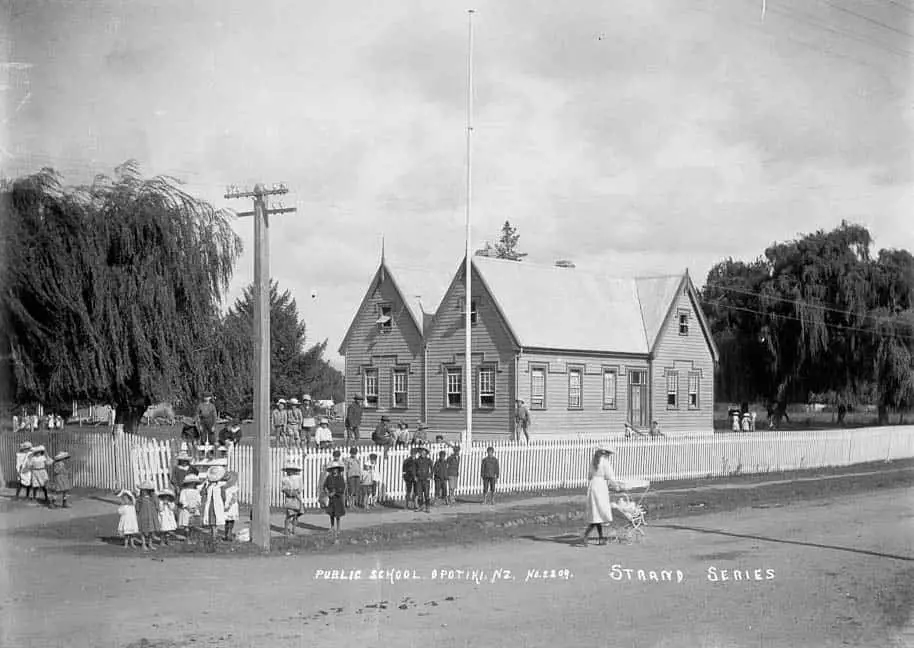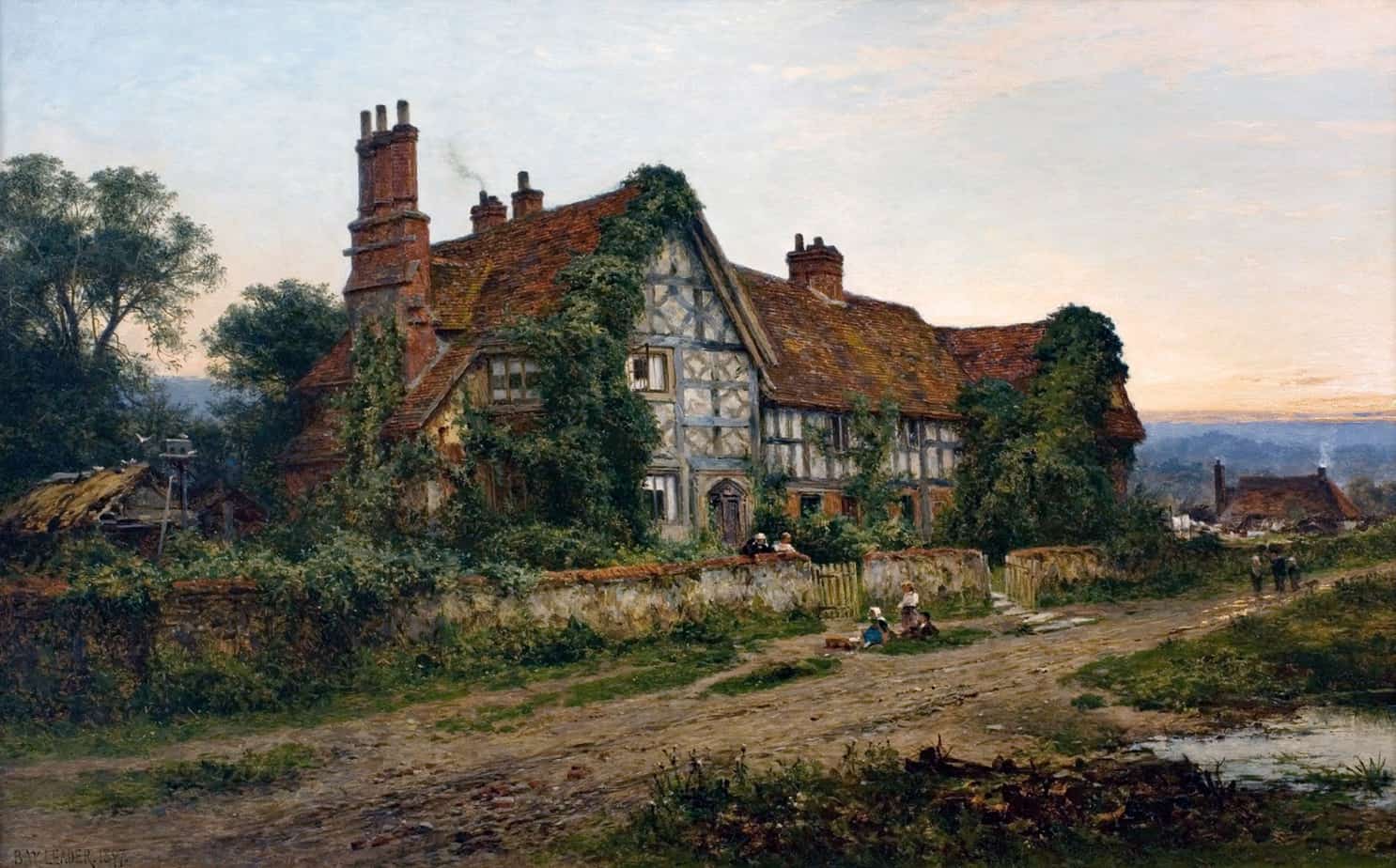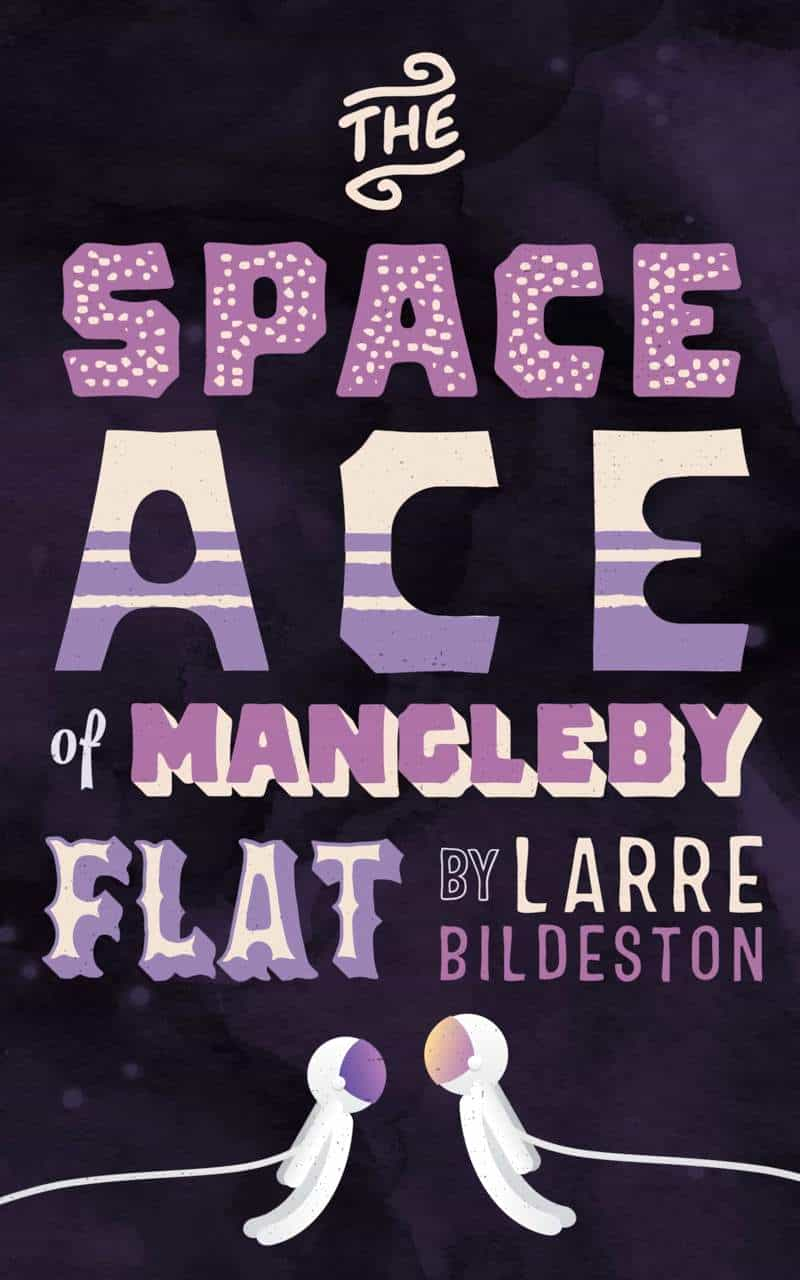“The Doll’s House” is a short story by Katherine Mansfield, set in New Zealand, written 1922. This is Mansfield’s most accessible story, and a good introduction to her work. Its main themes are seen across children’s literature as well. Unlike stories such as “The Garden Party” and “Bliss”, the reader is not required to fill in so many gaps by interpreting imagery. Readers are told exactly what happens.
(It always bothers me that the apostrophe doesn’t come after the ‘s’ in dolls’ house, since more than one doll always lives there…)
Margaret Drabble reads “The Doll’s House” by Katherine Mansfield at The Guardian.
SETTING OF THE DOLL’S HOUSE
Schools looked like this around the time Katherine Mansfield was growing up in New Zealand — the New Zealand of her memory.

New Zealanders have long loved to tell ourselves the myth that New Zealand is without social class. “When Europeans settled in New Zealand, everyone was equal. Everyone started from scratch, and everybody drank at the same pubs, attended the same schools…”
That was never true. My earliest ancestor to New Zealand emigrated as a bannister maker. He went to New Zealand to make bannisters for rich people, who took their servants, their wealth and their attitudes with them. Nothing magical happened on that boat to wipe those slates clean.
It is true that for hard-working early settlers, climbing the economic hierarchy became a genuine possibility, given good luck, white skin and valuable skills. One line of my working-class ancestry managed to secure swathes of farmland, some of it in an area which is now central Christchurch. That land was stolen by a lawyer who duped a new widow and ran off to Australia with the late husband’s fortune. (Women weren’t taught much about money in those days.) My family’s newly acquired immigrant fortune was thereby lost, even more quickly than it was gained. (Back then, Australia might as well have been the other side of the world.) My own family’s example demonstrates the ebb and flow of fortune in a young, new land, but classist attitudes are slower to change.
Do they ever change? Mansfield encourages us to mull that one over.
SYMBOLISM OF THE DOLL’S HOUSE
Doll house stories inevitably utilise one of two literary effects (or even both at once):
- The miniature effect, in which a story set in a particular time and place represents times and places everywhere. (Click that link, because there are many other uses for it.)
- The mise-en-abyme effect, which I cover in detail in an Angela Carter short story. In Mansfield’s story, imagine a doll house inside a doll house inside a doll house and so on. This conveys the idea of a never-ending pattern. What’s the never-ending pattern? Classism. Each new generation learns the same old classism from the one before, transmitting it later to their own children. A dolls’ house is therefore the perfect symbol to convey how classist attitudes transmit across generations.
For other examples of dolls’ houses in literature, see this post. (Squirrel Nutkin was published in 1903 — was this a favourite of Katherine Mansfield? Mansfield was a teenager by that stage, but Potter’s stories found very wide appeal.)
The central image of “The Doll’s House” is the little lamp, often interpreted as a symbol of light and therefore of knowing. But the lamp is a symbol of tricks, shams and illusions:
It was even filled already for lighting, though, of course you couldn’t light it.
… you couldn’t tell it from a real one’.
This is very similar to how Beatrix Potter uses the doll house in “The Tale of Two Bad Mice“. Potter’s story would therefore make an excellent companion text to this one. Unlike the Burnell children, the two ‘bad’ mice are outraged to learn that the miniature food is fake. They have a tantrum and make a complete mess of the dollhouse. But I find “The Tale of Two Bad Mice” the most affecting of all Potter’s tales — we feel genuine sorrow for the mice, who looked forward to a wonderful treat, only to have their hopes dashed.
Let’s look more closely at the imagistic pattern described in “The Doll’s House”, focusing on the dollhouse itself:
the door was like a slab of toffee
very big, awful smell, big lumps of paint, the hook was stuck fast
as if they had fainted [describing the very stiff dolls]
These details reenforce the basic theme: the gradual revelation to a child of social discrimination and injustice.
Significantly, only Else seems to realise that the rich people’s ‘little teeny lamp’ is a sham.
STORY STRUCTURE OF “THE DOLL’S HOUSE”
SHORTCOMING
This is the story of a community rather than of an individual. This narrative choice fits the theme, because social strata requires an entire community in order to exist. As in “Sun and Moon”, it makes more sense to divide the cast into two ‘main characters’ — adults versus children.
Whenever rich and poor people interact in a story, you get immediate, ready-made conflict. The adults of this rural town resemble rural towns dotted throughout New Zealand today, with the stark division between landed farmers and the service industry workers who work for them, alongside the unemployed. Rural towns are the perfect arena for rich and poor to mingle together. Although some of the rich farmers’ children are sent away to high school, they do still tend to attend the local primary school together. Katherine Mansfield herself was sent away to ‘finishing school’. (My father always used to threaten to send me away to finishing school if I didn’t behave like a proper little lady, though but the 1980s such institutions no longer existed, and I never really understood the empty threat. Even in England, Princess Diana was the very last of the finishing school class of lady, alongside Penelope Keith’s character in To The Manor Born.)
The moral shortcoming of the adults: They have no empathy for people they consider beneath themselves.
The moral shortcoming of the children: The children are emulating their adults, and this story is a snippet of indoctrination. The little girls mimic their mothers exactly, and the in-group, out-group bias is evident in the playground, where niceties are extended in return for social favours. You could even draw parallels between the doll’s house and the housing market, which is even more of a social issue than it was back then, when even the servant class were able to afford their own small cottage. In contemporary New Zealand there is an ever-increasing class divide between those who can own their own homes (and rental properties), and those who will never afford the payments on a the most modest of mortgages. This year, Prime Minister Jacinda Ardern created legislation preventing offshore ownership of New Zealand real estate, in an attempt to put a lid on this problem.
Anthony Browne covered similar issues in his picture book Voices In The Park. Before children learn who they may and may not talk to, they are inclined to talk to everyone. Browne’s book would make a good companion text to “The Doll’s House”.
NARRATION
Another short story master who tends to write communities rather than individuals is Annie Proulx. If you want to create a story with community themes, it’s all in your choice of narration:
Imagine a camera, attached to a silent drone. This drone follows Mrs Hay, who leaves a doll’s house with the Burnells, then flies over to the Burnell children, goes with them to school, flies up to pan out and include the Kelvey girls, who wait in the wings. For the big struggle scene it follows Aunt Beryl, but we accept this change in point of view because Mansfield never settles in on any single individual. Finally, it rests with the Kelvey girls, who are given the final word. This moment of sweetness makes the rest of the story all the worse.
DESIRE
The Burnell children are proud of their new dolls’ house and they want to tell everybody about it.
OPPONENT
The web of opposition is:
- Children versus adults (though the children don’t realise this — to them, it’s perfectly natural that the Kelveys would be excluded.)
- The children have their own social hierarchy, and Mansfield does a good job of depicting the hierarchy of a schoolyard, with its false niceties and the ‘designated untouchables’.
For more on that see Bullying In Children’s Literature.
PLAN
The Burnell children scheme between themselves how to milk this doll’s house for all the social capital it’s worth. They decide who’s going to pick friends to come home and view it, how to create momentum. (If the era were different, Isabel would have found great success in a marketing career.)
Little Kezia eventually gets sick of her big sister taking all the glory, and she makes her own plan: To invite the Kelveys to see it. (I imagine everyone else has seen the doll’s house by this point.)
BIG STRUGGLE
When Aunt Beryl finds the Kelveys in the yard she shoos them out as if they are chickens, later described as rats.
There may have been another reason, apart from the father in gaol/servant reason given, that the Burnell adults refused to allow poor children into their yard, treating them as disease-spreading rodents. The following is a fairly new theory, to do with the discovery that Harold Beauchamp (Katherine Mansfield’s father) probably moved the family out to the ‘country’ (now pretty central Wellington) to escape a bacterial plague affecting the old central Wellington:
What if, Yska wondered, Harold Beauchamp moved his family inland to escape what was nothing less than a galloping bacterial plague? The more he looked, the more clues he found in Mansfield’s stories – instances long seen as coded references to class consciousness. What if there was an alternative or companion subtext to her stories’ famous theme: “Don’t let little Kezia play with the washerwoman Kelvey’s little tykes”?
Yska says the reality wasn’t that the Beauchamps were snobs, but that at a certain point, they realised socialising with people from the poorer parts of central Wellington could literally kill them. For, as is ever the case, the poor succumbed to the plague first.
Noted
ANAGNORISIS
I doubt Kezia had any sort of epiphany regarding social class and exclusion and untouchable culture. She most likely learned that the Kelvey girls are too disgusting to enter the yard, and she won’t dare associate with them again.
In this story, the revelation is for the reader rather than for the characters, who are victims of the cogs of the local social hierarchy.
Apart from being asked to offer critique of classism, the paragraph with Aunt Beryl offers an insight into human psychology: Adults get mad at children when their own personal lives aren’t working out. This has nothing to do with the children, but children (similar to the adult servant class) bear the brunt. Or, ‘shit travels down’, as corporate workers well know. (I believe Americans say ‘shit rolls downhill’.)
NEW SITUATION
The ending serves to underscore this: The underclass are learning their place. This isn’t just one-sided, with the upper class learning their place at the top. The Kelvey girls are meek. They don’t complain.
Else is satisfied that she’s seen the little lamp. She’s ‘forgotten the cross lady’. As time goes by, she’ll not necessarily remember the Burnells’ Aunt Beryl at all, and she may barely remember that little lamp. But all of these micro-aggressions add up, and by the time she’s grown, Else will know her place in the social hierarchy: firmly at the bottom.
This ending is similar to that of “Her First Ball” in which an underdog character has an unpleasant interaction then apparently forgets all about it.
There is a concept in psychology known as “relative deprivation“
by which disenfranchised groups, having been trained to expect little, tend paradoxically to report the same levels of satisfaction as their better-treated, more privileged peers.
Lili Loofbourow, The Female Price of Male Pleasure
Because the Kelvey sisters are so socially and materially deprived, the opportunity to view a fancy doll’s house makes their day, despite the inevitable (to them) ostracisation which follows.
There are subcategories of relative deprivation. It can work the other way, in which a disenfranchised group or individual looks at far more privileged others around them and this maximises their dissatisfaction. Mansfield covered this variety of relative deprivation in “The Tiredness of Rosabel“.
Header painting: Benjamin Leader – A Relic of the Past. I chose this painting not because it is set in New Zealand but because of the children playing, and because the angle makes the foregrounded house look so much bigger than the cottage.


